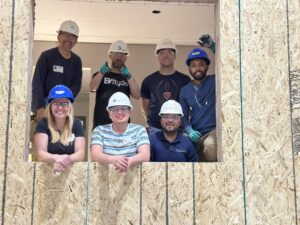Last month, I discussed the need for precompression in a post-tensioned slab. In that post, I mentioned that the code minimum amount of precompression is 125 psi for elevated slabs.
I’ve also mentioned some of the various types of elevated decks in the past. One of the more popular systems is called a one-way slab — deep beams span in one direction, and uniform tendons support a very thin slab (as little as 6″) between them. Because of the amount of load that lands on the beams (and their length), they end up with a very large amount of precompression. Unfortunately, the code also limits the amount of that precompression that we can spread into the slab.
As such, we frequently end up with situations where we have to add tendons between the beams simply to squeeze the slab together. These are called temperature tendons — so called because, like temperature reinforcement, they resist non-gravity loads . . . such as thermal expansion and contraction. The design assumption for these tendons is that they are placed exactly at mid-depth of the slab, squeezing both top and bottom symmetrically.
However, The ACI Manual of Concrete Practice allows these tendons to be adjusted vertically provided “the resultant of the shrinkage and temperature tendons . . . not fall outside the kern area of the slab.” What does that mean? So long as the compression squeezes both the top and bottom of the slab (rather than squeezing one, and stretching the other), the actual measurement to the center of the temperature tendon doesn’t have to be perfect. In practice, if the tendon is in the center third of the slab, the engineer of record will allow it.
So — how do Denver Dads save $$$? There are actually three parts to that simple trick.
- Temperature tendons need to be supported like any other. However, if the uniform tendons are within the center third of the slab at that location, simply laying the temperature tendons on top of them will keep the temperature tendons at the right elevation. Once they’re tied in place, the temperature tendons won’t accidentally move during concrete placement. No chairs or rebar is required . . . and the money to pay for them goes back into your pocket.
- Support bars are required for uniform tendons in part because it’s very easy to kick one tendon bundle during concrete placement unless it’s laterally stabilized. Since we’ve already tied the temperature tendons to the uniform strands, we’ve got serious lateral stability, so why not just throw the support chair directly under the uniform tendon, and leave the support bar out altogether? This can cut literally tons of rebar out of a large project.
- When the uniform tendons are just a little bit too high to support the temperature tendons, why not put the temperature tendons down on the support chair first, then tie the uniform tendons on top? One more stick of rebar, never shipped and never paid for.
These tricks all require two things: approval from the Engineer of Record, and careful detailing by the post-tension material supplier. If the EOR isn’t on board, this plan doesn’t fly, and the “like-new post-tension tendon support chair” market is pretty soft, so it doesn’t help to use these tricks if the material was ordered without taking them into consideration. EVstudio is always willing to help you with value engineering — and we’ve done enough post-tension detailing that we know how this should work. And if you aren’t in Denver, or you aren’t a Dad — don’t worry, we can make this trick work for you, too.








